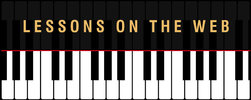 Every few months it's a good idea to check in with your piano playing and see where you are in terms of your growth and how well you're moving towards your goals. There are a lot of things that we have to learn in order to play the piano well you're probably finding that out as you continue on this journey. Sometimes we can get bogged down when we spend too much time focusing on just one or two things and we can end up behind in terms of reaching our goals. This is true with all areas in our lives really and if you think about it, you probably already have some sort of "check-in" system going in some of those other areas already. We check in before we go to the food store to replenish our pantries, we check in with our bank account to make sure we're staying on budget before shopping, we check in with our bathroom scales to see if we're keeping our weight goals...there are lots of ways that we do this. With our piano playing, we often just move from one piece to another or one exercise to another without reviewing what we've just learned and how that helps or hinders us in our overall growth. Instead of just moving through our piano repertoire this way, let's see what specific things we can look at with each new piece and exercise to make sure they are keeping us on track with our piano playing goals and timeline.
As you can see, the common factor with each of these steps is that they are written down. However you want to do it, a visual list that you can refer to works wonders when it comes to staying on track with any goal. A very effective way to plan your goals is to use the above list to establish a weekly practice routine. Things you want to include each week are:
Now this is just a suggested outline for your weekly goals. Each of us must adapt it according to the time we really have to invest in our playing. Be realistic with the amount of time you have to practice so you can really achieve your goals. At the end of each week, sit down and play through everything that you learned while you have your list handy to look at. How did you do with each item on the list? <--- This is the check-in part! In fact, you could put a check mark by the items that you mastered easily, and by the ones that you need more time on, put something else there so you know to revisit them the following week. If you need to adjust your timeline, don't hesitate to do so. The point of all of this is to give you something concrete to hold and look at so you can measure your piano growth and see realistic results by following a plan. Take some time in the next couple of weeks to go over what you have learned this year the piano. You might be surprised to find out just how much you really did learn and accomplish! We musicians tend to be very self-critical, so looking at what you've accomplished on paper actually helps to relieve some of these frustrating critics inside our heads. Stay Tuned to PianoLessonsOnTheWeb.com to learn much more and achieve your dream of playing the piano! |
AuthorMost blogs written by Archives
June 2020
Categories
All
|

 RSS Feed
RSS Feed